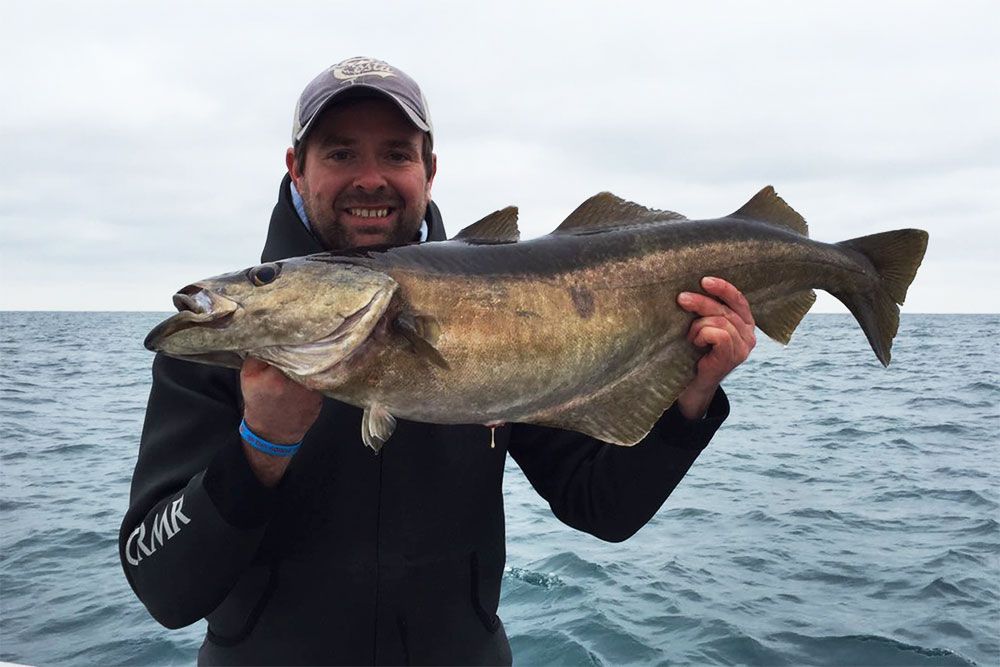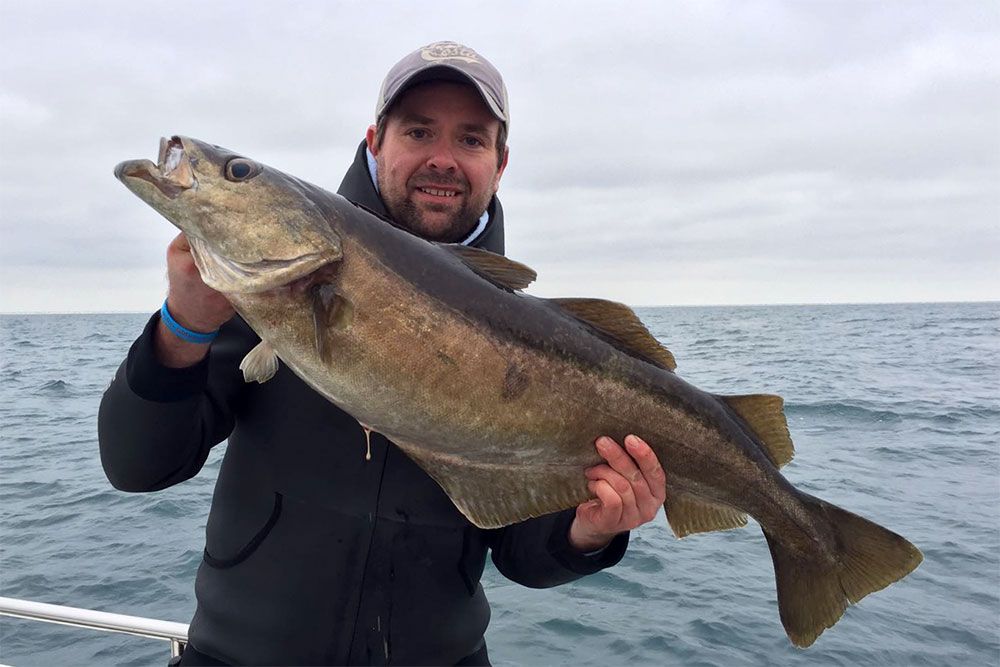This blog was first published on the 2nd of February 2017 and was last updated on the 13th of September 2022.
If you’ve never fished for winter wreck pollack on light tackle before, you’re missing out on some of the most exciting light tackle fishing the UK has to offer. Here in my native Sussex the bass fishing keeps us busy for most of the year, as we approach the new year though, our attention turns to pollack. The south coast is littered with wrecks from both world wars and these sea bed sanctuaries hold some monster pollack! Fishing wrecks can be a surreal experience, for some reason I always try to visualise what went on the day the wreck we’re fishing over went down. It can be an eerie feeling, especially when the fog stars to lay down. A percentage of wrecks we fish are either broken up or covered in commercial fishing gear but most hold some seriously big fish.
Pollack are the gangsters of wreck land, known for their explosive hit and runs and on light gear, when they hit, the hit like an express train. The current British record pollack stands at an incredible 29lb 4oz, caught off Kent in 1986. The English Channel still surrenders a few twenty pound plus fish each year, but these are mostly on snaggy wrecks, so it can be a real tussle to get them out without getting smashed up, as with everything, you take your chances.

TACKLE FOR WINTER WRECK POLLACK
For many years (and still to this day) your typical winter wreck pollack gear would be an 8’6 to 9’’ uptide rod with a 6000/7000 sized multiplier reel loaded with 30lb braid and a flying collar set up. The Flying C as we call it consists of a boom, lead and longish leader, with a sidewinder or redgill attached to the end. There is no doubt this setup has caught stacks of fish but, it’s seriously overkill as to what can be used for the same situation.
When I’m fishing for winter wreck pollack with soft plastics my kit consists of a HTO Nebula SP 2.5m rod paired with a 4000 sized reel such as the HTO Lure Game. The reel is loaded with HTO Nebula X8 Braid PE 1.0 (20lbs) and a leader of six to eight feet of 20lbs HTO Nebula FC Fluorocarbon. Braid is essential and the Nebula X8 like many modern braids is extremely thin causing less drag in the water allowing you to fish much lighter. The leader is added for two reasons. Firstly, braid has zero stretch so a length of leader will act as a shock absorber when a big fish hits hard and starts to run. Secondly, when fishing at close quarters to snaggy areas, modern braids can fray when encountering sharp edges and damage easy. The fluorocarbon leader helps to eliminate that problem.

The HTO Nebula SP 2.5m is rated from 10 to 42g and has a lovely action which bends into fish well but, more important than that, this action won’t rip hooks out of fish as they crash dive. As I’ve mentioned before, big pollack hit hard so it’s vitally important that you set the drag up correctly. Whilst we all love the sound of a screamer, these fish will happily hit you 30 feet above a wreck and take you all the way back down before you can adjust your drag. These big girls are tough customers so make sure your drag is set properly at all times.
LURES
We use a whole host of lures when targeting winter wreck pollack, the most important factor is making sure you have a wide range of different weight lures to cover all situations. Glassy, flat calm seas are rare so you have to have all of your bases covered.
The AXIA Mighty Minnow is a go to lure for big winter wreck pollack. In its larger size, the 56g version is fairly light so to fish it on its own, the drift speed needs to be under a knot for it to reach the bottom in time for you to retrieve it back up over the wreck structure. If you find drift speeds are faster, you can add a small drilled bullet which will sit directly on top of the jig head. His will get you straight down to the bottom. The Mighty Minnow comes in 12 different colours and they all seem to work as good as each other.

If I need to get down further then the AXIA Mighty Eel is a great choice, at 63g it is heavier than the Mighty Minnow and at 175mm it is the perfect length for a pollack to engulf. These lures are tough and in testing proved their metal well. They come in eight different colours and again, all colours are effective on their day.
TECHNIQUE
When you arrive at the chosen wreck the skipper will do a dummy drift to see how the boat is going to drift given the conditions. When you’re about to fish the first thing you need to remember is that you’re not fishing a Flying C here, there is no big old lead weight bounding around, you’re tied directly to the lure…it’s just you and the fish.
When the skipper signals that you can start to fish you open the bail arm and let the lure sink to the kill zone. The skipper will have placed you uptide of the wreck so you drift down over the top and down the back of it. The key here is to close the bail arm and start the retrieve as soon as you hit bottom, making sure you count every turn of the handle. This is vital as it gives you the indication of where the action is happening resulting in more fish.

You may find that you’re getting plucks on the lure from pollack as they show interest in the lure, the key is to be patient and not strike these, just keep retrieving until the rod buckles over. There is no mistaking a full force take by a pollack, even small fish will give the rod a good whack. There are days when pollack like to chase, they love the lure retrieved fast and when this is the situation you need to really hold onto your rod! The hits can be incredible and ferocious and you need to be prepared. On other days when fish are slow and lethargic a slow and steady retrieve can usually tempt a few hits. It’s all about what’s happening on the day, so always be prepared to switch things around to make the most of any opportunity.
RELEASE THEM IF YOU CAN
Pollack in general are prone to blown swim bladders, sometimes this can’t be avoided however, it’s not a race when you bring them up from the depths. If you take your time they can be returned with no issue at all. There are a few good venting tools on the market which will deflate the bladders to aid the return of the fish, there is plenty of videos and blogs out there which show you how to do this and a quick google search will get you the info you need.


